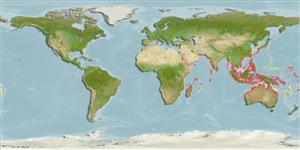Common names from other countries
Environment: milieu / climate zone / depth range / distribution range
экология
морской; солоноватоводный донно-пелагический. Tropical; 35°N - 37°S, 20°E - 178°W
Indo-Pacific: Persian Gulf to Fiji and north to Japan. Known from Delagoa Bay, Mozambique and Suez Canal on the African coast. Western Atlantic: introduced at Trinidad and Panama Canal near Atlantic end (Ref. 26938).
Size / Вес / Возраст
Maturity: Lm ? range ? - ? cm
Max length : 9.5 cm SL самец/пол неопределен; (Ref. 4404); наибольший возраст (опубликованны данные): 4 годы (Ref. 11441)
колючие лучи спинного плавника (общее число) : 11 - 13; членистые (мягкие) лучи спинного плавника (общее число) : 19 - 24; колючие лучи анального плавника: 2; членистые (мягкие) лучи анального плавника: 20 - 26. Head without cirri and crest. Lower end of gill opening opposite upper margin of pectoral fin. Sensory pores in infraorbital and interorbital canals mostly 8 and 3 respectively. Lateral line usually 7 to 11. Horizontal stripes on body distinct in male, but somewhat obscure in female.
Adults occur in coastal and brackish waters among rocks and mangroves (Ref. 9710). Oviparous. Eggs are demersal and adhesive (Ref. 205), and are attached to the substrate via a filamentous, adhesive pad or pedestal (Ref. 94114). Larvae are planktonic, often found in shallow, coastal waters (Ref. 94114). Highly tolerant to adverse environmental conditions, self-reproducing population living between rocks in natural oil seeps in Venezuela (Ref. 56126).
Life cycle and mating behavior
Maturities | размножение | Spawnings | Egg(s) | Fecundities | личинки
Oviparous, distinct pairing (Ref. 205).
Springer, V.G., 1986. Blenniidae. p. 742-755. In M.M. Smith and P.C. Heemstra (eds.) Smiths' sea fishes. Springer-Verlag, Berlin. (Ref. 4404)
Статус Красного Списка МСОП (Ref. 130435)
CITES (Ref. 128078)
Not Evaluated
Угроза для людей
Harmless
Использование человеком
рыболовство: интереса не представляет
дополнительная информация
инструменты
Специальные отчеты
Скачать в формате XML
ресурсы в Интернет
Estimates based on models
Preferred temperature (Ref.
115969): 24.7 - 29.1, mean 28.4 (based on 2724 cells).
Phylogenetic diversity index (Ref.
82804): PD
50 = 0.5000 [Uniqueness, from 0.5 = low to 2.0 = high].
Bayesian length-weight: a=0.00741 (0.00410 - 0.01339), b=3.09 (2.92 - 3.26), in cm Total Length, based on LWR estimates for this species & (Sub)family-body (Ref.
93245).
Trophic level (Ref.
69278): 2.5 ±0.1 se; based on size and trophs of closest relatives
устойчивость к внешним воздействиям (Ref.
120179): средний (среднего размера), минимальное время удвоения популяции 1.4-4.4 года (tmax=4).
Fishing Vulnerability (Ref.
59153): Low vulnerability (10 of 100).
